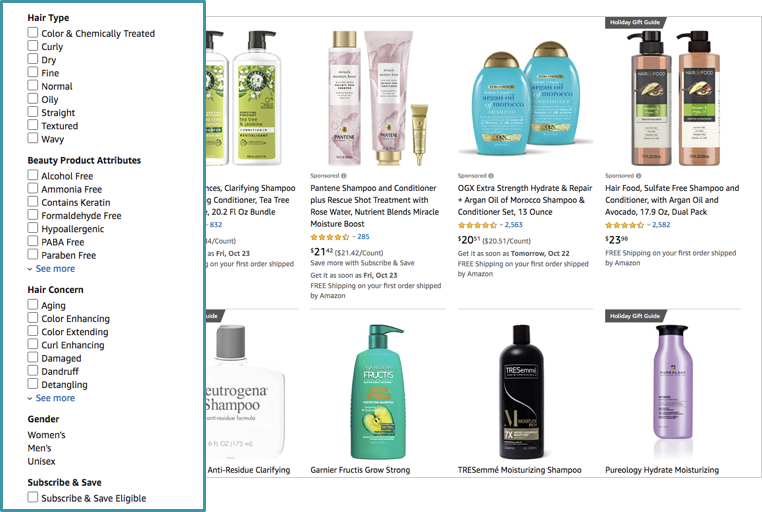Amazon Listing Optimization — 6 Advanced Strategies

You’ve heard it time and time again: Amazon isn’t for the faint-hearted.
Competition is fierce.
The rules of engagement are strict.
And success is about more than just selling the right products—it’s about making sure that your listings are noticed!
You need to know the science and art behind listing on Amazon to stand out. This entails understanding the basic know-how of listing in eCommerce and what makes Amazon’s algorithm tick.
Below are listing optimization tips to keep in mind as you evaluate your own Amazon listings. Establish these best practices early to avoid doubling back in the future or losing out on potential high-value sales.
Why Is Amazon Listing Optimization Important?
An Amazon product listing refers to the product detail page for each item you sell on Amazon. Product listings contain detailed information about your product, including the product title, product images, product descriptions, price, shipping information, and more.
Why should you optimize your Amazon product pages? The answer is simple. Amazon, like Google, is a search engine. Amazon's search algorithm aims to match phrases customers type into the search bar with the most relevant products available.
A well-optimized product listing makes it easier for potential customers to find your products, and get all the relevant details to make a purchase decision.
The optimization of Amazon product listings is crucial for several reasons:
🔶Boosting product visibility: Optimized listings can improve your product's visibility in Amazon's search results. When you use relevant keywords, Amazon's A9 algorithm is more likely to match your product to a customer's search query.
🔶Conversion: A well-optimized listing attracts potential buyers and provides clear, compelling information about a product, encouraging customers to purchase. High quality images, detailed descriptions, and positive reviews can all increase conversion rates and sales.
🔶Product ranking: Amazon's A9 algorithm determines the ranking of products in search results. Factors like keyword relevance, price, availability, sales history, and customer reviews are all considered. When you optimize Amazon product listings, your listing rank will improve.
🔶Customer trust: An informative and professional listing helps to build customer trust. Customers are likelier to purchase from listings that provide thorough product and brand details.
While Amazon is constantly reevaluating and reworking its algorithm, some factors will likely always impact your product’s ranking. We’ll discuss the six most important ones below.
| 💎 Want more info on product listing optimization in general? Have a look at our guide How To Optimize Your Product Listings! |
Tip #1: Fill Out as Many Product Details as Possible
Imagine walking into a store to buy a new shirt. The first thing you do is locate the men's or women’s aisle. Then you’ll find the rack with the particular brand or shirt type you want. Finally, you’ll find your size group and sift through the aisle for the right design, color, or cut.
As consumers, we are wired to filter our searches until we find what we’re looking for. Our behavior online is no different. We instinctively click through multiple screens, apply search filters, or input detailed queries to narrow our options.
Now as an Amazon seller, your job is to ensure your Amazon listing doesn’t get filtered out prematurely. That requires giving Amazon enough product details to work with.
For example, if you’re selling a hair product like shampoo, it benefits you to specify the hair type and hair concerns it addresses. While these attributes may not be required, you can tell that buyers care about these details by looking at the left-hand filter menu.

Should buyers click or search for any of these details specifically, there’s a high chance that your product won’t be included if it doesn’t have those attributes filled out on the backend. So, when populating your product listing, always choose the most accurate product categories.
An added benefit is that the more product information your listing has, the more likely it is to appear in organic search results.
|
The bottom line: Take the time to add extra details so that your product is listed everywhere it needs to be on Amazon. |
Tip #2: Do Thorough Keyword Research

Another basic housekeeping measure is to include keywords in your product detail pages, especially your product title, which is arguably the most essential part of your listing from a keyword perspective. Taking this one step further, you should always look for the right keywords to include in your Amazon listings.
However, remember, Amazon is not Google. While both search engines require keyword optimization, the same strategy doesn't necessarily apply to both. Daniel Sugarman, co-founder and CEO of Zentail, also warns against "keyword stuffing"—cramming numerous keywords based solely on their popularity rather than their relevance.
It's vital to find search terms that genuinely relate to your product rather than using keywords with a high search volume that might not serve your purpose.
To find relevant keywords, use Amazon listing optimization tools like Keywordtool.io and Ahrefs to do keyword research. These keyword research tools can help you find popular, relevant keywords that add value to your product listings.
Another simple technique for doing keyword research is to use Amazon's search bar to see which auto-fill suggestions emerge as you begin typing root words. This can give you an idea of commonly searched phrases related to your product.
However, when it comes to how many keywords to use, remember the goal is to attract relevant traffic and surface the right competitors at the right price point. Don’t go overboard and overcrowd your listing with too many keywords that might land your $35 product next to a much cheaper $10 one, which isn't ideal.
🔶Backend keywords
Another consideration regarding Amazon search engine optimization is backend keywords. Backend keywords on Amazon are search terms that you, as a seller, can input into a field in the backend of your product listing in an Amazon Seller Central account.
These search terms are not visible to customers viewing your product page, but Amazon's search engine uses them to determine when to display your product in the search results. Effectively utilizing backend keywords relevant to your product is crucial to Amazon SEO (search engine optimization).
Tip #3: Optimize Product Listings
Aside from keywords, product listings can be broken down into the following components:
➡️Product title
➡️Product images
➡️Key product features
➡️Product description
➡️A+ content (also known as enhanced brand content)
Every product listing component should help online shoppers decide that your product is the right choice for them. Your listing should be SEO-optimized both for maximum visibility and to stand out from the competition.
Below we’ll briefly touch on how to optimize your Amazon listings:
🔶Product title
As mentioned above, the most important keywords on your listing are the ones in your product title. Amazon has precise guidelines for product titles. These vary by category and provide insights into the types of queries buyers typically submit, helping you to further optimize your product listings.
You can also read our article on how to optimize your product title in more detail.
🔶Product images
Amazon allows Amazon sellers to upload up to nine product images, including the main image. Try to fill all these spots with high quality pictures, aiming for a size of 1,000 pixels in width and 500 pixels in height.
We suggest using a plain white backdrop for your main image. For the rest, optimize images by including images of your product from different angles, images that showcase its packaging, and lifestyle images of the product being used. Amazon guidelines state that the product should take up at least 85% of the image.
Also, be sure to make the size of your product clear in the photos. A lot of negative reviews come from buyers who were surprised by the actual size of the product — "It's way smaller than I thought" is a common complaint.
🔶Key product features
Amazon gives you a 1,000-character space to highlight your product's key features. Use this to convince potential buyers that your product outshines your competitors’ offerings, focusing on its benefits and practical applications.
Imagine you're the customer, and use each bullet point to help them envision the experience and advantages of using your product.
This could mean presenting real-world uses or explaining how your product solves their problems.
While bullet point lengths vary by category on Amazon, around 200 characters is usually enough to detail features and include key phrases. Remember, Amazon currently only ranks the first 1,000 characters of the bullet points, so keeping each bullet to 200 characters ensures all will be indexed.
🔶Product description
Amazon provides a 2,000-character space for you to tell potential buyers about product features. Aim to utilize as much of the 2,000-character limit as possible and further explain any features you mentioned in your bullet points.
Don’t over-embellish here, as you don’t want to mislead the buyer or create expectations your product can’t meet.
|
💡Pro-Tip: Invest in A+ Content Enhanced brand content, now known as A+ Content, is a set of advanced content features exclusive to brand owners on Amazon. A+ content lets sellers integrate additional rich-text images, extra bullet points, and comparison charts right into their product descriptions. A product listing with A+ Content will almost always outsell a listing with traditional, limited description features. |
Tip #4: Leverage Ads
As mentioned earlier, Amazon prioritizes listings likely to land a sale in its SERPs. Sales history is one of the biggest indicators of whether your product will sell. Investing in paid advertising is a great way to get the ball rolling for new sellers or products that lack a long history of success.
Commonly referred to as the “Flywheel Effect”, ads and your organic positions go hand in hand. Ads can help you attract initial sales (or grow sales on slow-moving products) and customer reviews. This then triggers the algorithm to take notice and provides long-term benefits for your organic rankings.
“[Brands are] using their ads offensively to improve SEO,” says co-founder of Straight Up Growth, Daniel Tejada, in an “Ask the Ecommerce Experts” interview with Zentail.
“Some of those brands that historically have not had to advertise are now having that conversation as they're starting to see lower sessions, lower sales because that SEO has started to slip...So frequently...the first organic product [on Amazon] is also one with the top ad placement for Sponsored Products. That's not an accident.”
Tip #5: Bulk Up on Reviews

Reviews are sacred on Amazon, both from a visibility and conversion perspective. It’s not hard to see that a high-ranking listing on Amazon tends to have hundreds, if not thousands, of reviews already and at least a 4-star rating.
Consider doing several things to get your review count up. First and foremost, make sure your product is exactly how you describe it on your product detail page. Many sellers innocently overstate or under explain the key features of their products, which sets them up for failure.
For instance, you may be tempted to use subjective terminology like “best” or “miraculous” when writing your product description to beef up its benefits. But buyers with extremely high expectations may be more inclined to return your product after purchase, claiming it doesn’t live up to the hype. Alternatively, you might lack pictures showing your product at scale or being used so that buyers may be disappointed by its size or functionality.
Along the same lines, you’ll want to ensure you can ship orders as quickly as you promise. Both Amazon and buyers reward fast, on-time shipping. Using eCommerce automation software like Spark Shipping can help to achieve that by making sure your inventory, vendors, and orders remain in sync.
Beyond this, consider promoting your listings or enrolling in Amazon’s Early Review Program to amass more reviews proactively. Collecting many positive reviews will signal to A10 that you’re a trustworthy seller with a product that meets buyers’ needs.
|
💡Pro-Tip: Engage with all reviews, good and bad. You will likely receive negative feedback. We recommend that you respond immediately. A well-worded response with a solution goes a long way in building customer trust. |
Tip #6: Make Sure the Price Is Right
There are consequences to both underpricing and overpricing a product. From an SEO perspective, what matters most is that your pricing is competitive. Amazon’s algorithm may pre-determine how likely your product is to sell based on your price and award you the Buy Box.
Moreover, if you overprice your product or increase prices above an acceptable range, then your sales may take a hit. This could have long-term ramifications. Since Amazon regularly checks sales history and conversion rates, your listing may fall in the rankings as its performance declines.
So, before adjusting your prices, take the time to research the competitive landscape thoroughly. If your pricing is higher than competitors, ensure you have legs to stand on. For example, check that you have better or more reviews or a unique product advantage that justifies a higher price point.
In Closing
Optimizing your listings on Amazon takes some time and thought. It requires knowing the factors that the algorithm regularly checks, plus going a few steps further than the majority of Amazon sellers.
Don’t just pick obvious keywords that everyone else is vying for. Avoid skimping on product details, even if they aren’t required.
Finally, remember to seize all the tools around you—ads, Amazon keyword research tools, or even software like Spark Shipping that simplifies inventory management—to automate your dropshipping business. The success of your Amazon business depends on it.
Popular Posts
Posts by Topic
- Dropshipping (5)
- Dropship Suppliers (3)
- EDI (3)
- Amazon Seller Central (2)
- Conversion Rate Optimization (2)
- Dropshipping Products (2)
- Order Management (2)
- Pricing Strategy (2)
- Vendor Product Catalog (2)
- Dean Soto (1)
- Dropshipping Automation (1)
- Feature Announcement (1)
- Online Empire Academy (1)
- Product Optimization (1)
- Shipping (1)
- referral marketing (1)